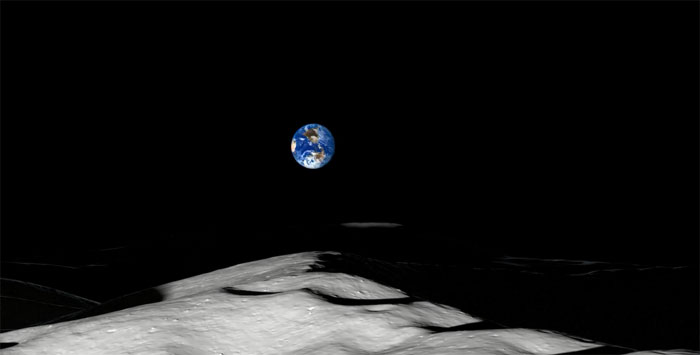Image of the Earth seen from the Moon's south pole
NASA hopes astronauts will be able to see Earth first-hand from the Moon's poles by the end of the 2020s.
(Video: NASA)
NASA's science graphics studio at Goddard Space Flight Center in Maryland shared a short video simulating a view from the Moon's south pole over three months. During that time, the Earth rose and fell several times while the brilliant Sun moved across the horizon. Even the Earth passes in front and obscures the Sun, in contrast to the lunar eclipse we see from the ground.
"For an observer on Earth, this is a lunar eclipse, in which the Moon passes through the Earth's shadow. However, viewed from the Moon, it is a solar eclipse," NASA said.

Simulation of Earth observed from the Moon's south pole.
The virtual camera in the graphic is located on the Shackleton crater rim , partially appearing in the lower right corner of the frame. This is the area that NASA targeted during the Artemis Moon landing mission. The agency hopes to be able to bring astronauts to the surface by the end of the 2020s. A series of mission-supporting rovers under the Commercial Lunar Payload Services (CLPS) program could fly to the Moon early this year. 2022.
NASA's Artemis 1 unmanned mission will fly around the Moon and return to Earth, scheduled to launch in February 2022. This mission has been delayed several times due to technical issues. The next mission, Artemis 2, will carry a Canadian astronaut around the Moon in 2023. NASA hopes the Moon landing mission Artemis 3 can take place in 2024.
The above timelines are subject to change during Artemis 1 mission completion, technology development, and funding applications.
- The pole from the North of the Earth is ... shifting
- How does the compass tell us where the North pole is at the South Pole?
- 'The third pole' of the Earth is melting
- What terrible disaster will happen if the Earth has 67 moons?
- In the future will the sun grow in the west?
- Dive into the South Pole Sea 97m, the world record
- The south pole of Hai King is the warmest
- Why did the North Pole move toward London?
- Why do magnets stick together?
- The solar field is about to turn polar
- The north pole from the Earth is moving
- The moon is the coldest place in the solar system
 Van Allen's belt and evidence that the Apollo 11 mission to the Moon was myth
Van Allen's belt and evidence that the Apollo 11 mission to the Moon was myth The levels of civilization in the universe (Kardashev scale)
The levels of civilization in the universe (Kardashev scale) Today Mars, the sun and the Earth are aligned
Today Mars, the sun and the Earth are aligned The Amazon owner announced a secret plan to build a space base for thousands of people
The Amazon owner announced a secret plan to build a space base for thousands of people